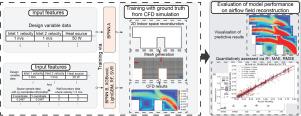评估基于 CFD 的室内气流场重建代用模型的监督机器学习回归模型
IF 7.1
1区 工程技术
Q1 CONSTRUCTION & BUILDING TECHNOLOGY
引用次数: 0
摘要
快速可靠地预测室内气流分布对室内环境控制至关重要。虽然神经网络(NN)(通常可互换为后向传播神经网络(BPNN))在气流预测中很受欢迎,但由于其 "黑盒 "性质和复杂的网络结构,优化这些模型具有挑战性。本研究探索了用于预测室内气流的其他稳健回归模型,包括基于决策树的模型(如 XGBoost、LightGBM、随机森林)和支持向量回归(SVR)。最初开发了两种 BPNN 结构,以评估 NN 模型的可行性。BPNN A 使用两个进气口的气流速度作为输入神经元进行训练,以直接预测域内的气流速度分布。BPNN B 使用空间信息进行额外训练,包括空间样本和边界墙数据。将 BPNN B 的高维训练结构应用于基于决策树的模型和 SVR,以评估其预测非线性气流模式的能力。结果表明,BPNN A 的准确率最高,而 BPNN B 中包含的高维数据则导致准确率下降。在所有基于决策树的模型中,XGBoost 表现出了最大的潜力,其 R2 超过 99.5%,预测误差低于 10%。XGBoost 的速度也优于两个 BPNN 模型,比 BPNN A 快 15.78 倍,比 BPNN B 快 252 倍。通过分析特征重要性,进一步探讨了 XGBoost 的可解释性,这有助于确定在预测气流速度时最具影响力的输入变量。这一分析有望加深对边界条件的理解,从而优化室内环境策略。本文章由计算机程序翻译,如有差异,请以英文原文为准。

Evaluation of supervised machine learning regression models for CFD-based surrogate modelling in indoor airflow field reconstruction
Fast and reliable prediction of indoor airflow distribution is critical for indoor environment control. While neural networks (NN), often interchangeably referred to as Back Propagation Neural Networks (BPNNs), are popular for airflow predictions, optimising these models is challenging due to their ”black box” nature and complex network structures. This study explores alternative robust regression models, including decision-tree-based models (e.g., XGBoost, LightGBM, Random Forest) and Support Vector Regression (SVR), for predicting indoor airflow. Two BPNN structures were initially developed to evaluate feasibility of NN models. BPNN A was trained using airflow velocities from two inlets as input neurons to directly predict the airflow velocity distribution within the domain. BPNN B was trained additionally with spatial information, including space samples and boundary wall data. Higher-dimensional training structures of BPNN B were applied to decision tree-based models and SVR to assess their capability in predicting non-linear airflow patterns. Results indicated that BPNN A achieved the highest accuracy, while the inclusion of higher-dimensional data in BPNN B led to decreased accuracy. Among all decision-tree-based models, XGBoost demonstrated the greatest potential, achieving an R above 99.5% and predictive errors below 10%. XGBoost also outperformed both BPNN models in speed, being 15.78 times faster than BPNN A and 252 times faster than BPNN B. The interpretability of XGBoost was further explored by analysing feature importance, which helps identify the most influential input variables while predicting the airflow velocity. This analysis is expected to offer an enhanced understanding of boundary conditions leading to optimised indoor environment strategy.
求助全文
通过发布文献求助,成功后即可免费获取论文全文。
去求助
来源期刊

Building and Environment
工程技术-工程:环境
CiteScore
12.50
自引率
23.00%
发文量
1130
审稿时长
27 days
期刊介绍:
Building and Environment, an international journal, is dedicated to publishing original research papers, comprehensive review articles, editorials, and short communications in the fields of building science, urban physics, and human interaction with the indoor and outdoor built environment. The journal emphasizes innovative technologies and knowledge verified through measurement and analysis. It covers environmental performance across various spatial scales, from cities and communities to buildings and systems, fostering collaborative, multi-disciplinary research with broader significance.
 求助内容:
求助内容: 应助结果提醒方式:
应助结果提醒方式:


